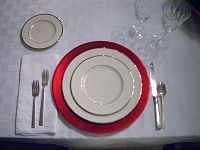Charger (table setting)

Charger plates or service plates are larger decorative plates used to dress up dinner tables at parties, weddings, and other special events. While the charger plates have been around since the 19th century, they returned to popularity in the late `90s. Since food is not actually served on chargers, they are often called underplates or chop plates.[1] The word "charger" originated around 1275 - 1325 from the Middle English "chargeour". Formerly, a charger signified either a large platter or a large, shallow dish for liquids.[2]
They are usually larger than most common dinner plates. Since they are not used for food, charger plates can be found in a variety of materials, from traditional china, to metal, wood, glass, plastic and pearl. And they may be decorated with substances that can be toxic if ingested.
Charger plate etiquette and use varies among caterers and restaurants. Some professional catering companies remove the decorative charger plate as soon as the guests are seated. More commonly, charger plates are kept on the table during the serving of soups and first courses, and act as a base on which food-bearing bowls and dishes are placed. In other instances, when the design of charger plates complements the design of dining plates, charger plates are left on the table throughout the course of meal. However, charger plates are always removed before serving desserts.[1]
Culture
In Mark 6:25, KJV and Matthew 14:8, KJV, the "daughter of Herodias" requested John the Baptist's head in a "charger" from Herod Antipas as her reward for dancing at his birthday party.[3][4][5]
See also
| Wikimedia Commons has media related to Category:Charger plates. |
References
- ↑ 1.0 1.1 "Role of charger plates in tabletop design | Glass Dinnerware Solutions For Restaurants". The-glass-co.com. Retrieved 2011-10-10.
- ↑ Webster's Encyclopedic Unabridged Dictionary of the English Language, Random House, Inc. 1996.
- ↑ Mark 6:25, KJV
- ↑ Matthew 14:8 KJV
- ↑ "Matthew 14:8". Online Parallel Bible. Retrieved October 14, 2011.